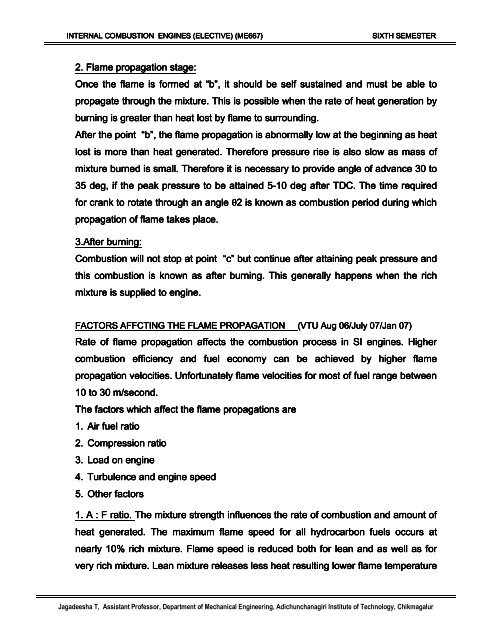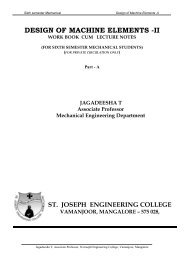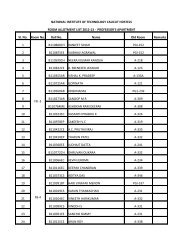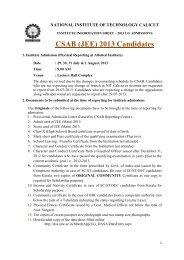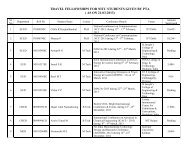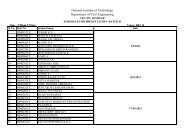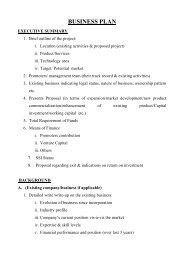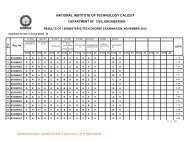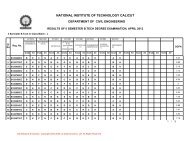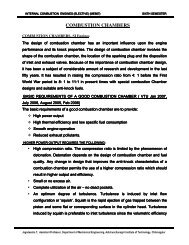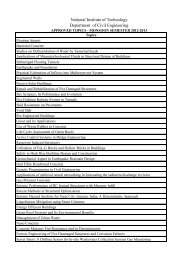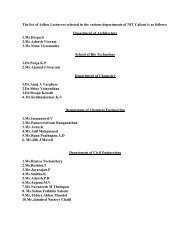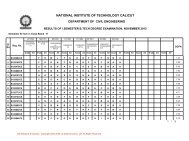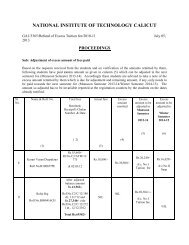combustion process in si engines - National Institute of Technology
combustion process in si engines - National Institute of Technology
combustion process in si engines - National Institute of Technology
Create successful ePaper yourself
Turn your PDF publications into a flip-book with our unique Google optimized e-Paper software.
INTERNAL COMBUSTION ENGINES (ELECTIVE) (ME667)<br />
SIXTH SEMESTER<br />
2. Flame propagation stage:<br />
Once the flame is formed at “b”, it should be self susta<strong>in</strong>ed and must be able to<br />
propagate through the mixture. This is pos<strong>si</strong>ble when the rate <strong>of</strong> heat generation by<br />
burn<strong>in</strong>g is greater than heat lost by flame to surround<strong>in</strong>g.<br />
s<br />
After the po<strong>in</strong>t “b”, the flame propagation is abnormally low at the beg<strong>in</strong>n<strong>in</strong>g as heat<br />
lost is more than heat generated. Therefore pressure rise is also slow as mass <strong>of</strong><br />
mixture burned is small. Therefore it is necessary to provide angle <strong>of</strong> advance ance 30 to<br />
35 deg, if the peak pressure to be atta<strong>in</strong>ed 5-10 deg after TDC. The time required<br />
for crank to rotate through an angle θ2 2 is known as <strong>combustion</strong> period dur<strong>in</strong>g which<br />
propagation <strong>of</strong> flame takes place.<br />
3.After burn<strong>in</strong>g:<br />
Combustion will not stop at po<strong>in</strong>t “c” but cont<strong>in</strong>ue after atta<strong>in</strong><strong>in</strong>g peak pressure and<br />
this <strong>combustion</strong> is known as after burn<strong>in</strong>g. This generally happens when the rich<br />
mixture is supplied to eng<strong>in</strong>e.<br />
FACTORS AFFCTING THE FLAME PROPAGATION<br />
(VTU Aug 06/July 07/Jan 07)<br />
Rate <strong>of</strong> flame propagation affects the <strong>combustion</strong> <strong>process</strong> <strong>in</strong> SI eng<strong>in</strong>es. Higher<br />
<strong>combustion</strong> efficiency and fuel economy can be achieved by higher flame<br />
propagation velocities. Unfortunately flame velocities for most <strong>of</strong> fuel range between<br />
10 to 30 m/second.<br />
The factors which affect the flame propagations are<br />
1. Air fuel ratio<br />
2. Compres<strong>si</strong>on ratio<br />
3. Load on eng<strong>in</strong>e<br />
4. Turbulence and eng<strong>in</strong>e speed<br />
5. Other factors<br />
1. A : F ratio. The mixture strength <strong>in</strong>fluences the rate <strong>of</strong> <strong>combustion</strong> and amount <strong>of</strong><br />
heat generated. The maximum flame speed for all hydrocarbon fuels occurs at<br />
nearly 10% rich mixture. Flame speed is reduced both b<br />
for lean and as well as for<br />
very rich mixture. Lean mixture releases less heat result<strong>in</strong>g lower flame temperature<br />
Jagadeesha T, As<strong>si</strong>stant Pr<strong>of</strong>essor, Department <strong>of</strong> Mechanical Eng<strong>in</strong>eer<strong>in</strong>g, Adichunchanagiri <strong>Institute</strong> <strong>of</strong> <strong>Technology</strong>, Chikmagalur


